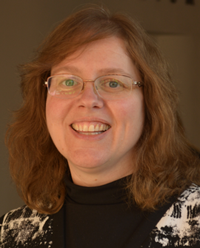Anita Schuchardt, an assistant professor in Biology Teaching and Learning recently received a CAREER grant from the National Science Foundation, a program that supports research of early-career faculty. The grant aims to help students — and empower educators — to apply mathematical knowledge to biological systems.

Schuchardt, who before completing a PhD in learning sciences, taught high school biology for years, is familiar with the tendency to silo subjects into neat 50-minute periods. High school students are prone to thinking that math should stay in math class and writing shouldn’t leave English class. Some educators, largely because of limited resources for professional development, are prone to stick to their subject lanes too. When math shows up in biology class, many students are caught off guard. Schuchardt, among others, is hoping to break down those silos and views it as a critical shift in biology education.
“Folks are proclaiming mathematics is biology’s next microscope,” says Schuchardt. “It’s where the next huge advances are coming from in the field and given this, we need to help students hone their quantitative skills.”
The grant itself has several major components. One is to develop modules that fit into specific courses, which will allow educators to more readily plug activities into their existing framework without having to re-work a syllabus or re-name a class.Another is to better understand how instructors are currently bringing math into their coursework and the reasoning behind their approaches. This will inform the development of new modules and help Schuchardt enter conversations with fellow educators more informed.
One strategy Schuchardt uses in her modules is to encourage students to develop their own forumulas before taking a look at the formula in the textbook. It’s pretty common for students to encounter math in biology as a formula in a textbook. Although these formulas are helpful for spitting out specific calculations, they’re often so simplified that they don’t connect to the biology of the system.
Instead of adopting these formulas, Schuchardt encourages students to make connections and develop formulas in small groups. This process gives students the space and time to make connections between biology and math. The goal isn’t for student groups to come up with the same formula, it’s to have them engage in deeper discussions about the system.
Known as “sense making,” these mental gymnastics are an important skill to flex when developing models.
Gaining a better understanding about how students and educators think about mathematics in biology and learning where they struggle are major goals of the research. “If we can better identify pain points — both for students and educators — we can design modules and plans that can take these into consideration,” says Schuchardt. —Claire Wilson